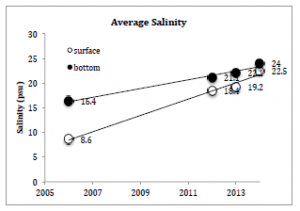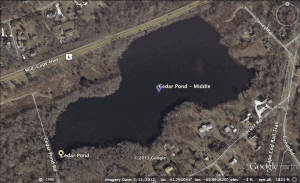Cedar Pond and Rock Harbor Estuary
The Cedar Pond – Rock Harbor estuary system falls within the towns of Orleans and
Eastham and has aesthetic, economic, and environmental value to both towns. Over the years, there have been a number of modifications to this system as a result of residential and commercial development. Within this watershed there are just over 400 septic systems. The study also found a direct source of nitrogen from a parking lot catch basin and a pipe that drains an adjacent marsh was contributing a significant source of nitrogen to the estuary. Further utility wires that pass over Cedar Pond have become a roosting spot for daily populations of up to 600 migratory cormorants (http://www.capecodtimes.com/article/20150707/NEWS/150709538, http://capecodtoday.com/article/2015/08/11/225736-USDA-takes-Cedar-Pond-cormorants-Orleans). All of these modifications to the system have impacted water quality.
Cedar Pond is of particular interest because of it’s unique history in that it was originally considered by the town to be freshwater, supplied by groundwater inflows, but the increasing tidal exchange with nearby rock harbor has had dramatic effects and changed the pond from fresh/brackish to a coastal salt pond.
Water quality was monitored at the mouth of Rock Harbor, in Rock Harbor Creek, in the Dyer Prince tributary, at the culvert connecting Rock Harbor Creek to Cedar Pond, and within Cedar Pond
There was a clear gradient in declining water quality from the well-flushed mouth of the estuary towards the headwaters. Samples taken near the mouth of Rock Harbor typically had low levels of nutrients and chlorophyll, good water clarity, and healthy levels of dissolved oxygen. Conditions gradually worsened the farther upstream the sample was taken. Cedar Pond, at the head of this system, was badly degraded, especially during the summer months when the water column was stratified. The bottom waters had high levels of total nitrogen and total phosphorous, and very low levels of dissolved oxygen, characteristic of a highly eutrophic system.
Of particular concern were the relatively high levels of contaminants of emerging concern (CECs) detected in Cedar Pond during this study. Compared to ten other estuaries and ponds on Cape Cod, the total concentration of detectable CECs were highest in Cedar Pond. Concentrations of two (estrone and DEET) were higher in Cedar Pond than any other area tested.
Over the past few years of the study as the  higher salinity water from Rock Harbor Creek has continued to enter Cedar Pond the salinity in the pond has increased sufficiently to break down stratification. This has caused the increase in dissolved oxygen in the pond and a decrease in nutrient levels. The data collected from CCS from 2012-2015 suggest that as salinity continues to increase, decreasing the density difference between surface and bottom waters and allowing for mixing of the water column, water quality conditions will continue to improve.
higher salinity water from Rock Harbor Creek has continued to enter Cedar Pond the salinity in the pond has increased sufficiently to break down stratification. This has caused the increase in dissolved oxygen in the pond and a decrease in nutrient levels. The data collected from CCS from 2012-2015 suggest that as salinity continues to increase, decreasing the density difference between surface and bottom waters and allowing for mixing of the water column, water quality conditions will continue to improve.
Read more about the project and the Orleans Pond Coalition here

Our Work
Humpback Whale Research
Right Whale Research
Marine Animal Entanglement Response
Marine Geology Department
Water Quality Monitoring Program
Marine Fisheries Research
Seal Research
Shark Research
Marine Education
Interdisciplinary
Marine Debris and Plastics Program
Marine Policy Initiative
Cape Cod Climate Change Collaborative
Publications




